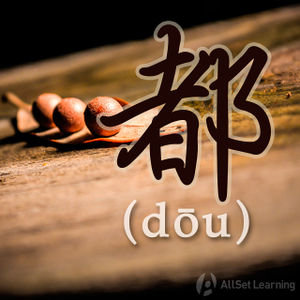Difference between revisions of "Expressing "every" with "mei""
| Line 17: | Line 17: | ||
<div class="liju"> | <div class="liju"> | ||
| − | * <em>每</em> 个 人 <strong>都</strong> 很 | + | * <em>每</em> 个 人 <strong>都</strong> 很 高兴 。 <span class="pinyin"><em>Měi</em> gè rén <strong>dōu</strong> hěn gāoxìng.</span> <span class="trans">Every person is very happy.</span> |
| − | * 你 <em>每</em> 次 <strong>都</strong> | + | * 你 <em>每</em> 次 <strong>都</strong> 迟到 。 <span class="pinyin">Nǐ <em>měi</em> cì <strong>dōu</strong> chídào.</span> <span class="trans">You are late every time.</span> |
| − | * <em>每</em> 个 人 我 <strong>都</strong> | + | * <em>每</em> 个 人 我 <strong>都</strong> 认识 。 <span class="pinyin"><em>Měi</em> gè rén wǒ <strong>dōu</strong> rènshi.</span> <span class="trans">I know every person.</span> |
| − | * 我 <em>每</em> 个 星期 <strong>都</strong> 学 | + | * 我 <em>每</em> 个 星期 <strong>都</strong> 学 中文 。 <span class="pinyin">Wǒ <em>měi</em> gè xīngqī <strong>dōu</strong> xué Zhōngwén.</span> <span class="trans">I study Chinese every week.</span> |
| − | * 他 <em>每</em> 年 <strong>都</strong> 来 | + | * 他 <em>每</em> 年 <strong>都</strong> 来 中国 。 <span class="pinyin">Tā <em>měi</em> nián <strong>dōu</strong> lái Zhōngguó.</span> <span class="trans">He comes to China every year.</span> |
| − | * 他 的 <em>每</em> 个 女朋友 <strong>都</strong> 很 | + | * 他 的 <em>每</em> 个 女朋友 <strong>都</strong> 很 漂亮 。 <span class="pinyin">Tā de <em>měi</em> gè nǚpéngyou <strong>dōu</strong> hěn piàoliang.</span> <span class="trans">Every one of his girlfriends are all very beautiful.</span> |
| − | * <em>每</em> 个 菜 <strong>都</strong> | + | * <em>每</em> 个 菜 <strong>都</strong> 好吃 。 <span class="pinyin"><em>Měi</em> gè cài <strong>dōu</strong> hǎochī.</span> <span class="trans">Every dish is delicious.</span> |
| − | * 我 <em>每</em> 天 <strong>都</strong> 不 吃 | + | * 我 <em>每</em> 天 <strong>都</strong> 不 吃 早饭 。 <span class="pinyin">Wǒ <em>měi</em> tiān <strong>dōu</strong> bù chī zǎo fàn.</span> <span class="trans">Every morning I don't eat breakfast.</span> |
| − | * <em>每</em> 种 啤酒 我 <strong>都</strong> 喝 | + | * <em>每</em> 种 啤酒 我 <strong>都</strong> 喝 了 。 <span class="pinyin"><em>Měi</em> zhǒng píjiǔ wǒ <strong>dōu</strong> hē le.</span> <span class="trans">I can drink every kind of beer.</span> |
| − | * <em>每</em> 个 国家 我 <strong>都</strong> 去 | + | * <em>每</em> 个 国家 我 <strong>都</strong> 去 过 。 <span class="pinyin"><em>Měi</em> gè guójiā wǒ <strong>dōu</strong> qù guò.</span> <span class="trans">I have been to every country.</span> |
</div> | </div> | ||
Revision as of 04:24, 29 October 2014
-
Level
-
Similar to
-
Used for
-
Keywords
Sometimes using the word 每 (měi) in a sentence feels incomplete without adding a 都 (dōu). Here we will learn how to use it properly.
Structure
The pronoun 每 (měi) covers the meanings of "each" and "every". It is often used with "都 (dōu)" in a complete sentence.
每 + Measure word + Noun + 都
Examples
- 每 个 人 都 很 高兴 。 Every person is very happy.
- 你 每 次 都 迟到 。 You are late every time.
- 每 个 人 我 都 认识 。 I know every person.
- 我 每 个 星期 都 学 中文 。 I study Chinese every week.
- 他 每 年 都 来 中国 。 He comes to China every year.
- 他 的 每 个 女朋友 都 很 漂亮 。 Every one of his girlfriends are all very beautiful.
- 每 个 菜 都 好吃 。 Every dish is delicious.
- 我 每 天 都 不 吃 早饭 。 Every morning I don't eat breakfast.
- 每 种 啤酒 我 都 喝 了 。 I can drink every kind of beer.
- 每 个 国家 我 都 去 过 。 I have been to every country.



